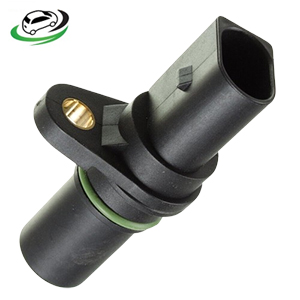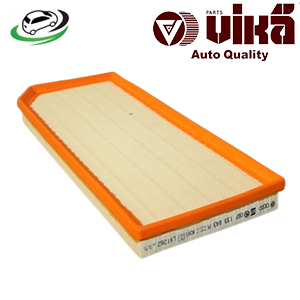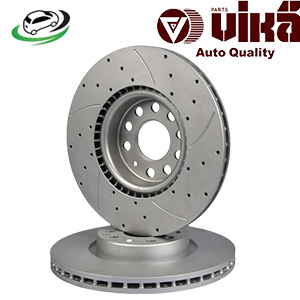-11%
Get Front Brake Disc Assy AUDI A1 8X1/8XA/A3 8PI/8V1 Q3 8U / VW Golf V/VI/Passat 3C5/Jetta IV 1K0615301AA
The brake disc assembly is a crucial component of a vehicle’s braking system, playing a vital role in ensuring safe and effective braking performance. It comprises several key parts that work together to bring the vehicle to a stop when the brakes are applied. This guide provides an in-depth look at the brake disc assembly, including its functions, construction, types, symptoms of wear, maintenance, and replacement procedures.
What is a Brake Disc Assembly?
The brake disc assembly, also known as a brake rotor assembly, is a component of the disc braking system in a vehicle. It consists of the brake disc (rotor) and associated parts, such as the hub and sometimes the bearing. The brake disc is mounted on the wheel hub and rotates with the wheel. When the brake system is engaged, the brake pads clamp onto the disc to create friction, slowing down or stopping the vehicle.
Functions of the Brake Disc Assembly
The brake disc assembly performs several critical functions in a vehicle’s braking system:
- Friction Generation: The primary function of the brake disc is to generate friction when the brake pads are applied. This friction converts the kinetic energy of the moving vehicle into heat, which slows down or stops the vehicle.
- Heat Dissipation: During braking, the brake disc absorbs and dissipates a significant amount of heat generated by the friction between the disc and brake pads. Effective heat dissipation is crucial to prevent brake fade and maintain consistent braking performance.
- Brake Pad Support: The brake disc provides a surface for the brake pads to press against. The even and consistent surface of the disc ensures that the brake pads wear evenly and maintain optimal contact for effective braking.
- Vehicle Control: By providing a reliable and consistent braking surface, the brake disc assembly helps maintain vehicle control during braking. Properly functioning discs contribute to stable and predictable braking performance.
- Noise and Vibration Reduction: High-quality brake discs are designed to minimize noise and vibrations during braking. This contributes to a quieter and smoother driving experience.
Construction of the Brake Disc Assembly
The brake disc assembly typically consists of several key components:
- Brake Disc (Rotor): The brake disc is the primary component of the assembly and is typically made of cast iron or carbon composite. It is mounted on the wheel hub and rotates with the wheel.
- Hub: The hub is the central part of the brake disc assembly that connects the brake disc to the wheel bearing and axle. It provides support and stability for the brake disc.
- Bearings: Some brake disc assemblies include bearings that support the rotation of the wheel and brake disc. These bearings ensure smooth and accurate rotation.
- Ventilation Channels: Many brake discs have ventilation channels or slots that help dissipate heat and improve cooling. These channels also help reduce brake fade and maintain braking performance.
- Mounting Bolts: The brake disc is secured to the wheel hub with mounting bolts. These bolts must be properly tightened to ensure the brake disc remains securely in place.
Types of Brake Discs
Brake discs come in various types, each designed for specific applications and performance requirements:
- Solid Brake Discs: Solid brake discs are the most basic type and are typically used in standard passenger vehicles. They consist of a single solid piece of metal and provide reliable braking performance for everyday driving.
- Ventilated Brake Discs: Ventilated brake discs, also known as slotted or perforated discs, have ventilation channels or slots that improve heat dissipation and cooling. They are commonly used in performance vehicles and high-demand applications to reduce brake fade and improve braking performance.
- Drilled Brake Discs: Drilled brake discs have holes drilled into the disc surface to enhance cooling and reduce weight. They are often used in high-performance or racing applications to improve heat dissipation and reduce the risk of brake fade.
- Slotted Brake Discs: Slotted brake discs have grooves or slots cut into the disc surface to improve braking performance and reduce noise. The slots help to channel away debris and gases generated during braking.
- Carbon-Carbon Brake Discs: Carbon-carbon brake discs are used in high-performance and racing applications. They are made of carbon fibers embedded in a carbon matrix, providing exceptional heat resistance and lightweight performance.
Symptoms of Worn or Damaged Brake Discs
Over time, brake discs can wear out or become damaged, leading to various symptoms that affect braking performance and safety. Common signs of worn or damaged brake discs include:
- Squeaking or Squealing Noises: Worn brake discs or glazed surfaces can cause squeaking or squealing noises during braking. This noise is often a sign that the brake pads or discs need attention.
- Grinding Noises: Grinding noises when braking can indicate that the brake pads have worn down to the metal, causing them to make contact with the brake disc. This can lead to further damage to the disc and reduced braking performance.
- Vibration or Pulsation: If you feel vibrations or pulsations in the brake pedal or steering wheel when braking, it may be a sign of warped or unevenly worn brake discs. This can affect braking performance and vehicle stability.
- Pulling to One Side: If the vehicle pulls to one side during braking, it may indicate uneven wear on the brake discs or a problem with the braking system. This can affect vehicle control and safety.
- Reduced Braking Performance: A noticeable decrease in braking performance, such as longer stopping distances or a spongy brake pedal, can indicate that the brake discs are worn or damaged. This can compromise vehicle safety.
- Visible Cracks or Grooves: Inspecting the brake discs visually may reveal cracks, grooves, or other signs of damage. These issues can affect the disc’s ability to provide effective braking and may require replacement.
Consequences of Ignoring Worn Brake Discs
Neglecting to address worn or damaged brake discs can lead to several serious consequences:
- Reduced Braking Performance: Worn or damaged brake discs can lead to decreased braking efficiency, increasing stopping distances and compromising vehicle safety. This can result in dangerous driving conditions and increased risk of accidents.
- Increased Repair Costs: Ignoring brake disc issues can lead to additional damage to the brake system, such as worn brake pads or damaged calipers. This can result in more costly repairs and extended downtime.
- Unsafe Driving Conditions: Poor braking performance, vibrations, or noise can create unsafe driving conditions. Properly functioning brake discs are essential for maintaining control of the vehicle and ensuring safe operation.
- Increased Risk of Accidents: Decreased braking performance and compromised vehicle control can increase the risk of accidents. Addressing brake disc issues promptly is crucial for ensuring the safety of the vehicle and its occupants.
Maintaining and Replacing Brake Disc Assemblies
Proper maintenance and timely replacement of brake disc assemblies are essential for ensuring safe and effective braking performance. The general steps for maintaining and replacing brake disc assemblies include:
- Regular Inspections: Inspect the brake discs regularly for signs of wear, damage, or uneven surface. Check for visible cracks, grooves, or other issues that may affect braking performance.
- Check Brake Pads: Regularly check the condition of the brake pads and replace them as needed. Worn brake pads can contribute to damage or excessive wear on the brake discs.
- Brake Disc Resurfacing: In some cases, brake discs can be resurfaced to remove uneven wear or minor damage. This process involves machining the disc surface to restore a smooth, even contact area. However, resurfacing has limitations and may not be suitable for all types of damage.
- Brake Disc Replacement: If the brake discs are severely worn, damaged, or beyond resurfacing, they should be replaced. Follow these general steps for replacing brake discs:
- Lift the Vehicle: Use a jack to lift the vehicle and secure it with jack stands. This provides access to the wheel and brake assembly.
- Remove the Wheel: Remove the wheel to access the brake components. This typically involves loosening and removing the lug nuts.
- Remove the Brake Caliper: Remove the brake caliper from the disc assembly by loosening the caliper mounting bolts. Carefully support the caliper to prevent damage to the brake line.
- Remove the Old Brake Disc: Remove any retaining bolts or clips securing the brake disc to the hub assembly. Carefully remove the old brake disc from the hub.
- Install the New Brake Disc: Position the new brake disc onto the hub and secure it with the appropriate bolts or clips. Ensure that the disc is properly aligned and seated.
- Reinstall the Brake Caliper: Reattach the brake caliper to the disc assembly and tighten the mounting bolts to the manufacturer’s specifications.
- Reinstall the Wheel: Place the wheel back onto the hub and secure it with the lug nuts. Tighten the lug nuts in a crisscross pattern to ensure even pressure.
- Lower the Vehicle: Carefully lower the vehicle and remove the jack stands. Test the braking system by applying the brakes gently to ensure proper operation.
Choosing the Right Brake Disc Assembly
When selecting a brake disc assembly, it’s important to choose high-quality parts that meet your vehicle’s specifications:
- OEM Discs: Original Equipment Manufacturer (OEM) brake discs are designed to meet the exact specifications of your vehicle. They offer reliable performance and compatibility.
- Aftermarket Discs: Aftermarket brake discs can vary in quality, so it’s important to choose a reputable brand. Look for discs that are tested for durability and performance.
- Performance Discs: For high-performance or racing applications, consider upgrading to performance brake discs with features such as ventilation channels or drilled/slotted surfaces for enhanced cooling and braking performance.
- Compatibility: Ensure that the brake disc assembly you choose is compatible with your vehicle’s make, model, and braking system. Verify the part number and specifications before making a purchase.
Follow us on Facebook for more parts.



